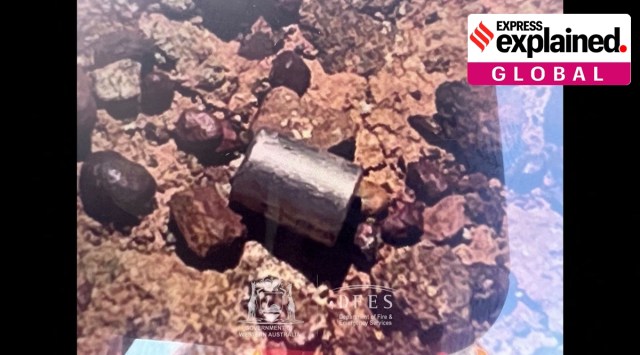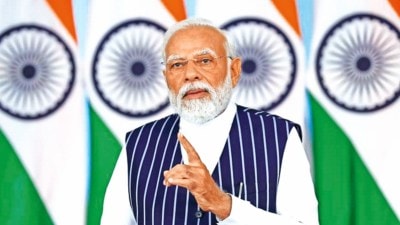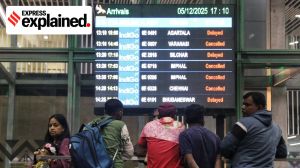Radioactive capsule lost – and found – in Australia: Here’s what happened
The Caesium-137 capsule lost in transit more than two weeks ago was discovered using specialist detection equipment which picked up the radiation.
 A view of the radioactive capsule lying on the ground, near Newman, Australia, February 1, 2023, in this still image obtained from a handout video. (Photo: Western Australian Department Of Fire And Emergency Services/Handout via REUTERS)
A view of the radioactive capsule lying on the ground, near Newman, Australia, February 1, 2023, in this still image obtained from a handout video. (Photo: Western Australian Department Of Fire And Emergency Services/Handout via REUTERS) On Wednesday (February 1), authorities recovered a tiny radioactive capsule, smaller than a coin, lost in Australia’s vast Outback. It took authorities a week-long search involving around 100 people along a nearly 1,400 kilometres stretch of highway, officials said.
The Caesium-137 capsule lost in transit more than two weeks ago was discovered when a vehicle equipped with specialist detection equipment picked up the radiation, despite travelling at around 70 km/h, according to officials from the state of Western Australia.
The search team then used portable detection equipment to find the capsule, which was located about 2 metres from the side of the road in a remote area far from any community, they added.
“When you consider the scope of the search area, locating this object was a monumental challenge, the search groups have quite literally found the needle in the haystack,” Western Australia’s Emergency Services Minister Stephen Dawson said.
How was the capsule lost?
The radioactive capsule was part of a gauge used to measure the density of iron ore feed from Rio Tinto’s Gudai-Darri mine. Located in the northern reaches of Western Australia, the recently opened mine is one of the most advanced in the world, with a high degree of automation.
The gauge was being taken from the mine to a facility in the suburbs of the state capital Perth – travelling a distance longer than the length of Great Britain. Officials said the capsule apparently fell off a truck during transport and landed on the side of the road. However, the details of just how exactly this happened are still unclear.
 Route of the truck carrying the Caesium capsule. (Source: Google Maps)
Route of the truck carrying the Caesium capsule. (Source: Google Maps)
What can be said with certainty is that the gauge was picked up from the mine on Jan 12. When it was unpacked on Jan. 25, it was found broken apart, with one of its four mounting bolts as well as screws and the capsule missing. Authorities suspect vibrations from the road train caused the gauge to break apart and the capsule fell out, reported Reuters.
How have the companies responsible reacted?
Rio Tinto, the mining company operating the Gudai Darri site, said in its statement: “We will be assessing whether our processes and protocols, including the use of specialist contractors to package and transport radioactive materials, are appropriate.”
Notably, SGS Australia was the company that packed the equipment containing the capsule and Centurion was in charge of its transportation. While the former is yet to comment on the issue, Centurion expressed surprise, saying that the crate and pallet provided by SGS arrived in Perth in the same condition as at the start of the journey, and GPS data had shown no sudden changes in speed.
“From a freight and logistics perspective this indicates a routine journey, and the fact that the crate was not opened for a week until after delivery reinforces that view,” Centurion said.
What are the risks that the capsule posed?
People had been told to stay at least five metres (16.5 feet) away if they spotted the capsule, because exposure could cause radiation burns or radiation sickness. However, driving past it was believed to be relatively low risk, akin to taking an X-ray, said Western Australian authorities.
 A supplied image obtained on Friday, January 27, 2023, of a small round and silver capsule containing radioactive Caesium-137 that went missing in transportation between a mine site north of Newman and the north-eastern parts of Perth. (Department Of Fire And Emergency Services/Handout via Reuters)
A supplied image obtained on Friday, January 27, 2023, of a small round and silver capsule containing radioactive Caesium-137 that went missing in transportation between a mine site north of Newman and the north-eastern parts of Perth. (Department Of Fire And Emergency Services/Handout via Reuters)
The biggest danger was that the capsule would be picked up by some unsuspecting person. This would not only endanger the person but potentially endanger their community as they went around, presumably with the capsule in their pocket.
Radioactive materials like Caesium-137 produce beta and gamma radiation, both of which are harmful for humans. When exposed to them, short term risks include that of radiation poisoning (which can be deadly) whereas in the long term, it can also be a cause of cancer and damage human DNA.
What is next?
Currently, a 20-metre exclusion zone has been set up around the capsule while defence force members verify it via a serial number. It will then be placed in a lead container and stored overnight at a secure location in Newman, a mining town roughly 1,200 km north-west of Perth, before being taken to the state capital on Thursday.
Experts say that the capsule, which emits radiation equal to roughly 10 X-rays per hour, was unlikely to contaminate the area it fell in.
Western Australia’s Chief Health Officer Andrew Robertson told Reuters that there would be an investigation and prosecutions would be considered under state radiation safety laws from 1975.
Currently, the maximum penalty for failing to safely handle radioactive substances is A$ 1,000 and A$50 per day the offence continues, though the state government said on Wednesday it was considering a change to laws to allow for bigger penalties.
- 01
- 02
- 03
- 04
- 05






































